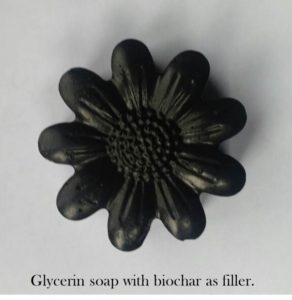 The versatility of biochar seems, at times, limitless. As the ever expanding uses of biochar continues, research is showing that biochar can be used either as something to be filled by other substances or as something to fill in other substances.
The versatility of biochar seems, at times, limitless. As the ever expanding uses of biochar continues, research is showing that biochar can be used either as something to be filled by other substances or as something to fill in other substances.
For most of biochar’s ancient and recent history it has been viewed predominantly as a “fillee” or carrier with countless pores to be filled with a wide variety of substances. Charging biochar’s nooks & crannies with nutrients, either organic (e.g. urine, manure, compost) or synthetic, can transform biochar into a slow-release fertilizer. Saturating pore space with water can convert biochar into something that can provide a low-cost, long lasting irrigation pathway. Filling pore space with other substances, such as herbicides, can improve efficiency of the herbicide while also reducing leaching. Packing biochar pores with microbial inoculants has shown that biochar can perform as well as or even better than other inoculum carriers such as peat moss or vermiculite. Suffice to say that biochar’s role as a long lasting pack mule is rather well established.
However life on the flip side of the fill equation is not nearly as well established as of yet but research is definitely beginning to show that biochar holds promise as a filler in various types of composites. Fillers have traditionally served to lower the cost of composites, but they can also improve various properties of plastics, paper, paints and more. Fillers come in many forms with calcium carbonate, wood flour and saw dust being amongst the most popular. More recent research has shown that biochar can reduce costs while simultaneously improving different mechanical and electrical properties in different types of composites. While much work remains to be done to understand which of biochar’s chemical, physical or biological properties are most relevant to improving various different properties in different types of composites, this new frontier of biochar research is bringing new talents (e.g. engineers of all sorts) into the biochar arena.
Regardless of whether its role is as a filler or fillee (not to be confused with a female horse), the added bonus of using biochar is that it is able to sequester carbon, and potentially other elements such as heavy metals which could be detrimental to the environment, for decades to millennia while also providing the other more immediate benefits described above. Biochar’s ‘ambidextrous’ nature when it comes to fill, increases exponentially its potential as a carbon sequestration tool. No longer constrained solely to use in soils, however plentiful those opportunities might be, above ground carbon sink opportunities abound for biochar in civil infrastructures as well as every day consumables (see soap pictured above). What other filler or fillee material can boast this much bang for the buck?

